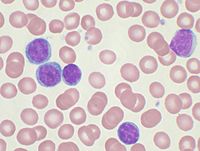
Photo from wikipedia
Simple Summary In many countries, the standard-of-care cytogenetic analysis of chronic lymphocytic leukemia (CLL) is based on the fluorescence in situ hybridization (FISH) technique. This offers only a very targeted… Click to show full abstract
Simple Summary In many countries, the standard-of-care cytogenetic analysis of chronic lymphocytic leukemia (CLL) is based on the fluorescence in situ hybridization (FISH) technique. This offers only a very targeted view of genomic alterations. Recent studies have demonstrated the potential of OGM as a cytogenetic tool for hematological malignancies. To confirm this for CLL, it is crucial to carefully evaluate the performance of OGM in detecting the routinely FISH-targeted aberrations in addition to its use as a genome-wide analysis method. We have evaluated the concordance of OGM and standard-of-care FISH in 18 samples from patients with CLL. Overall, the results were fully concordant between these two techniques. The genome-wide analysis revealed additional chromosomal aberrations in 78% of the samples and enabled the detection of complex karyotypes, which are undetectable by FISH. Based on our results, OGM could be used as a first-tier cytogenetic test for CLL. Abstract The fluorescence in situ hybridization (FISH) technique plays an important role in the risk stratification and clinical management of patients with chronic lymphocytic leukemia (CLL). For genome-wide analysis, FISH needs to be complemented with other cytogenetic methods, including karyotyping and/or chromosomal microarrays. However, this is often not feasible in a diagnostic setup. Optical genome mapping (OGM) is a novel technique for high-resolution genome-wide detection of structural variants (SVs), and previous studies have indicated that OGM could serve as a generic cytogenetic tool for hematological malignancies. Herein, we report the results from our study evaluating the concordance of OGM and standard-of-care FISH in 18 CLL samples. The results were fully concordant between these two techniques in the blinded comparison. Using in silico dilution series, the lowest limit of detection with OGM was determined to range between 3 and 9% variant allele fractions. Genome-wide analysis by OGM revealed additional (>1 Mb) aberrations in 78% of the samples, including both unbalanced and balanced SVs. Importantly, OGM also enabled the detection of clinically relevant complex karyotypes, undetectable by FISH, in three samples. Overall, this study demonstrates the potential of OGM as a first-tier cytogenetic test for CLL and as a powerful tool for genome-wide SV analysis.
Journal Title: Cancers
Year Published: 2023
Link to full text (if available)
Share on Social Media: Sign Up to like & get
recommendations!